The Bulldozer Review: AMD FX-8150 Tested
by Anand Lal Shimpi on October 12, 2011 1:27 AM ESTPower Management and Real Turbo Core
Like Llano, Bulldozer incorporates significant clock and power gating throughout its design. Power gating allows individual idle cores to be almost completely powered down, opening up headroom for active cores to be throttled up above and beyond their base operating frequency. Intel's calls this dynamic clock speed adjustment Turbo Boost, while AMD refers to it as Turbo Core.
The Phenom II X6 featured a rudimentary version of Turbo Core without any power gating. As a result, Turbo Core was hardly active in those processors and when it was on, it didn't stay active for very long at all.
Bulldozer's Turbo Core is far more robust. While it still uses Llano's digital estimation method of determining power consumption (e.g. the CPU knows ALU operation x consumes y-watts of power), the results should be far more tangible than what we've seen from any high-end AMD processor in the past.
Turbo Core's granularity hasn't changed with the move to Bulldozer however. If half (or fewer) of the processor cores are active, max turbo is allowed. If any more cores are active, a lower turbo frequency can be selected. Those are the only two frequencies available above the base frequency.
AMD doesn't currently have a Turbo Core monitoring utility so we turned to Core Temp to record CPU frequency while running various workloads to measure the impact of Turbo Core on Bulldozer compared to Phenom II X6 and Sandy Bridge.
First let's pick a heavily threaded workload: our x264 HD benchmark. Each run of our x264 test is composed of two passes: a lightly threaded first pass that analyzes the video, and a heavily threaded second pass that performs the actual encode. Our test runs four times before outputting a result. I measured the frequency of Core 0 over the duration of the test.
Let's start with the Phenom II X6 1100T. By default the 1100T should run at 3.3GHz, but with half or fewer cores enabled it can turbo up to 3.7GHz. If Turbo Core is able to work, I'd expect to see some jumps up to 3.7GHz during the lightly threaded passes of our x264 test:
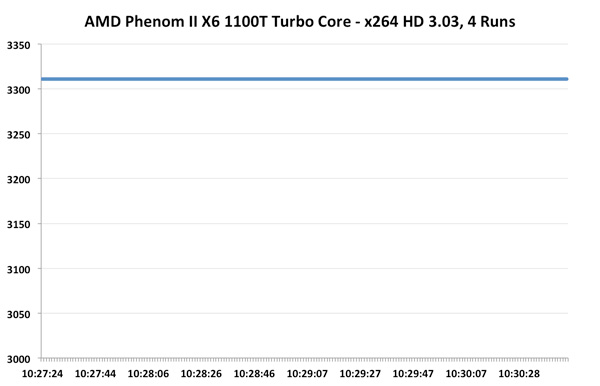
Unfortunately we see nothing of the sort. Turbo Core is pretty much non-functional on the Phenom II X6, at least running this workload. Average clock speed is a meager 3.31GHz, just barely above stock and likely only due to ASUS being aggressive with its clocking.
Now let's look at the FX-8150 with Turbo Core. The base clock here is 3.6GHz, max turbo is 4.2GHz and the intermediate turbo is 3.9GHz:
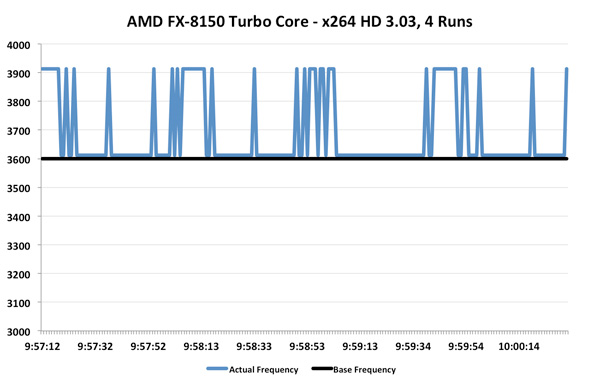
Ah that's more like it. While the average is only 3.69GHz (+2.5% over stock), we're actually seeing some movement here. This workload in particular is hard on any processor as you'll see from Intel's 2500K below:
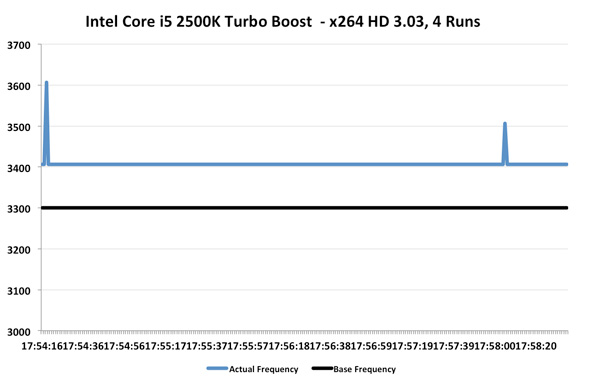
The 2500K runs at 3.3GHz by default, but thanks to turbo it averages 3.41GHz for the duration of this test. We even see a couple of jumps to 3.5 and 3.6GHz. Intel's turbo is a bit more consistent than AMD's, but average clock increase is quite similar at 3%.
Now let's look at the best case scenario for turbo: a heavy single threaded application. A single demanding application, even for a brief period of time, is really where these turbo modes can truly shine. Turbo helps launch applications quicker, make windows appear faster and make an easy time of churning through bursty workloads.
We turn to our usual favorite Cinebench 11.5, as it has an excellent single-threaded benchmark built in. Once again we start with the Phenom II X6 1100T:
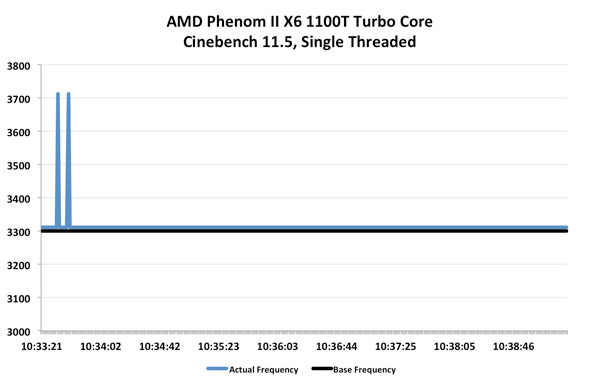
Turbo Core actually works on the Phenom II X6, albeit for a very short duration. We see a couple of blips up to 3.7GHz but the rest of the time the chip remains at 3.3GHz. Average clock speed is once again, 3.31GHz.
Bulldozer does far better:

Here we see blips up to 4.2GHz and pretty consistent performance at 3.9GHz, exactly what you'd expect. Average clock speed is 3.93GHz, a full 9% above the 3.6GHz base clock of the FX-8150.

Intel's turbo fluctuates much more frequently here, moving between 3.4GHz and 3.6GHz as it runs into TDP limits. The average clock speed remains at 3.5GHz, or a 6% increase over the base. For the first time ever, AMD actually does a better job at scaling frequency via turbo than Intel. While I would like to see more granular turbo options, it's clear that Turbo Core is a real feature in Bulldozer and not the half-hearted attempt we got with Phenom II X6. I measured the performance gains due to Turbo Core across a number of our benchmarks:

Average performance increased by just under 5% across our tests. It's nothing earth shattering, but it's a start. Don't forget how unassuming the first implementations of Turbo Boost were on Intel architectures. I do hope with future generations we may see even more significant gains from Turbo Core on Bulldozer derivatives.
Independent Clock Frequencies
When AMD introduced the original Phenom processor it promised more energy efficient execution by being able to clock each core independently. You could have a heavy workload running on Core 0 at 2.6GHz, while Core 3 ran a lighter thread at 1.6GHz. In practice, we felt Phenom's asynchronous clocking was a burden as the CPU/OS scheduler combination would sometimes take too long to ramp up a core to a higher frequency when needed. The result, at least back then, was that you'd get significantly lower performance in these workloads that shuffled threads from one core to the next. The problem was so bad that AMD abandoned asynchronous clocking altogether in Phenom II.
The feature is back in Bulldozer, and this time AMD believes it will be problem free. The first major change is with Windows 7, core parking should keep some threads from haphazardly dancing around all available cores. The second change is that Bulldozer can ramp frequencies up and down much quicker than the original Phenom ever could. Chalk that up to a side benefit of Turbo Core being a major part of the architecture this time around.
Asynchronous clocking in Bulldozer hasn't proven to be a burden in any of our tests thus far, however I'm reluctant to embrace it as an advantage just yet. At least not until we've had some more experience with the feature under our belts.


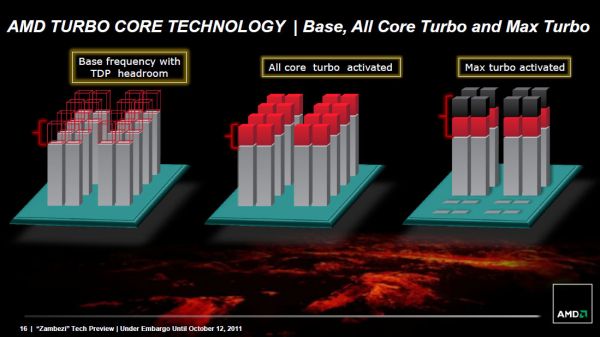








430 Comments
View All Comments
nofumble62 - Thursday, October 13, 2011 - link
Crappy building block will mean crappy building.richaron - Friday, October 14, 2011 - link
At first I was pissed off by being strung along for this pile of tripe. After sleeping on it, I am not completely giving up on this SERVER CHIP:1) FX is a performance moniker, scratch stupid amount of cache & crank clock
2) I'm sure these numbties can get single thread up to thuban levels
3) Patch windows scheduler ffs
Fix those (relatively simple) things & it will kick ass. But it means most enthusiasts wont be spending money on AMD for a while yet.
7Enigma - Friday, October 14, 2011 - link
Biggest problem for a server chip is the load power levels. It just doesn't compete on that benchmark and one in which is VERY important for a server environment from a cost/heat standpoint.Let's hope that's just a crappy leaky chip due to manufacturing but it's to early to tell.
richaron - Friday, October 14, 2011 - link
I've worked in a 'server environment'. of course power consumption is an issue. at the lower clock speeds & considering multithread performance, this is already a good/great contender. virtual servers & scientific computing this is already a winnar.with a few (hardware & software) tweaks it could be a GREAT pc chip in the long term.
ryansh - Friday, October 14, 2011 - link
Anyone have a BETA copy of WIN8 to see if BD's performance increases like AMD says it will.silverblue - Friday, October 14, 2011 - link
There's benchmarks here and there but nothing to say it'll improve performance more than 10% across the board. In any case, the competition also benefits from Windows 8, so it's still not a sign of AMD closing any sort of gap in a tangible fashion.Pipperox - Friday, October 14, 2011 - link
But Bulldozer is different.Windows 7 scheduler does not have a clue about its "modules" and "cores".
So for example it may find it perfectly legit to schedule 2 FP intensive threads to the same module.
Instead this will result in reduced performance on Bulldozer.
Also one may want to schedule two integer threads which share the same memory space to the same module, instead of 2 different modules.
This way the two threads can share the same L2 cache, instead of having to go to the L3 which would increase latency.
All of the above does not apply to Thuban; to a lesser degree it applies to Sandy Bridge, but Windows 7 scheduler is already aware of Sandy Bridge's architecture.
nirmv - Saturday, October 15, 2011 - link
Pipperox, It's not different than Intel's Hyper Threading.Pipperox - Sunday, October 16, 2011 - link
It is, although they're similar concepts.Let's make an example: you have 2 integer threads working on the same address space (for example two parallel threads working in the same process).
All cores are idle.
What is the best scheduling for a Hyperthreading cpu?
You schedule each thread to a different core, so that they can enjoy full execution resources.
What is best on Bulldozer?
You schedule them to the SAME module.
This because the execution resources are split in a BD module, so there would be no advantage to schedule the threads to different modules.
HOWEVER if the 2 threads are on the same module, they can share the L2 cache instead of the L3 cache on BD, so they enjoy lower memory latency and higher bandwidth.
There are cases where the above is not true, of course.
But my example shows that optimal scheduling for Hyperthreading can be SUB-optimal on Bulldozer.
Hence the need for a Bulldozer-aware scheduler in Windows 8.
Regs - Friday, October 14, 2011 - link
AMD needs a 40-50% performance gain and they're not going to see it using windows 8. What AMD needs is...actually I have no clue what the need. I've never been so dumbfounded about a product that makes no sense or has any position in the market.